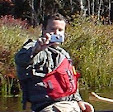 |
| Cab-forward paddling |
Where you put your body and place your strokes makes a big difference in performance. Think of your boat as having three zones - front, center and rear. You should spend most of your time paddling up front with forward and cross forward strokes. This "cab-forward" style helps you maintain speed and control. The next zone is the center. Strokes here are used to move the boat laterally and for braces, both of which are necessary. The place you want to spend the least amount of time is the rear. Strokes continued to the rear tend to kill momentum. Of course there are exceptions to every rule. When you have good forward speed and need a major correction, you can’t beat a good stern pry or reverse sweep.
 |
| Lean back to unweight the bow in a drop |
For most paddling, a slight forward lean will increase your stability and control by lowering your center of gravity and weighting the bow to engaging the forward chines for turns. Strokes at the stern cause you to have a slight back leaning posture, which can compromise your stability and balance. You will need to throw your weight back after a hard forward stroke to get a boof over a drop or unweight the bow when encountering a large wave below a drop,
 |
| Strong lean on a reverse sweeping turn into an eddy |
It is not enough to steer the boat with your paddle. You also need to steer with your hips. You do this by carving - leaning forward, tilting the boat onto one edge and engaging the forward chines. The boat will then turn to the side you engaged. Carving allows you to keep most of your strokes in the front of the boat while maintaining precise control over your turns.
 |
| Maintaining momentum over a drop |
Momentum is what allows you to go where you want to go, make the moves you want to make, and stay in control. When approaching difficult drops you want to build your speed and maintain through-out. When punching through holes, time your last stroke to catch the fast water flushing into the hole. When paddling in waves, a paddle stroke in the trough will accelerate you up the face of the wave to maintain speed and resist turning. When you encounter challenging features you need to keep your paddle in the water and paddle through it - driving the boat forward to maintain speed and control.
 |
| Use the troughs in waves |
Wave troughs are the doorways that allow you to exit eddies and cross currents gracefully. Enter the trough between the crest and use a slight angle to surf across the wave and build momentum. Tightening the angle will allow you to turn downstream or increase speed to complete an S-turn. Hidden among even the most complex rapids is often series of surfable wave troughs.
 |
| Eddy hopping downstream |
Many beginner paddlers try to run an entire rapid at once and hope for the best. With this approach you are much more likely to take on water, get thrown off your line, or encounter unexpected features. In bigger water it is better to break the rapid down into smaller, more manageable sections. Always be looking for your next eddy, and work to get there. Don’t leave that eddy until you pick out the next one downstream, and maybe a "plan-B" eddy just in case. Look for wave troughs and dry lines that keep you out of holes, pore-overs, etc. As soon as your boat is filled with water you lose speed and control and will find yourself fighting the current.
Start with tough moves on easy rapids
As you work to improve your skills, start with more challenging moves on easier water – tighter lines, bigger waves, harder ferries. This will allow you to progress more confidently to more difficult rapids.
As you work to improve your skills, start with more challenging moves on easier water – tighter lines, bigger waves, harder ferries. This will allow you to progress more confidently to more difficult rapids.
Links:




No comments:
Post a Comment
Note: Only a member of this blog may post a comment.